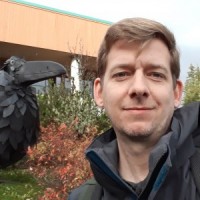CNAIR Stories: The Kwakwaka’wakw manuscripts of George Hunt
Image above: Studio portrait of George Hunt and Jonathan Hunt, 1920.
The manuscripts of George Hunt (1856-1931) are one of the largest and most important bodies of work by an Indigenous person at the APS Library. Born of a Tlingit mother and a Scottish father, Hunt was raised and married into the Kwagu'ł community (in the past referred to as "Kwakiutl") of Fort Rupert located near the northern end of Vancouver Island in British Columbia. In the 1880s, he met the anthropologist Franz Boas, and over the course of more than four decades they worked together, mostly through correspondence, with Hunt sending Boas over 6000 pages of stories, speeches, ethnographic information, maps, and other extremely detailed, multi-lingual manuscripts on not only the Kwagu'ł, but also many other tribes and families that comprise the Kwakwaka'wakw people, whose communities and territories include much of northern Vancouver Island and the adjacent islands and mainland to the east. The knowledge and words found in the manuscripts are, of course, not just that of Hunt, but also that of numerous Kwakwaka'wakw people whose experiences and expertise he recorded.
The Kwakwaka'wakw people continue to actively maintain their knowledge of the land, their history in it, and their cultural sovereignty through their language and traditional governance, despite the extraordinary damage caused by colonization, epidemic diseases, and governmental policies such as boarding schools and the Potlatch Ban (lasting from 1885-1951), which made illegal the practice of traditional ceremonies and the exercise of self-governance.

In 2015 and 2016, the APS was honored by an invitation to attend two Kwakwaka'wakw potlatches held in Alert Bay, British Columbia. At these traditional gatherings, the APS gave away books prepared for the occasion running several hundred pages each, containing unpublished manuscripts from the APS Library written by George Hunt in the Kwak'wala language and English. These books included stories, family histories, maps, and descriptions of traditional lifeways, and were distributed to the assembled hereditary chiefs, matriarchs, singers, and other community members. It is precisely these people who are the primary constituency, core experts, and research public for these manuscripts.

This distribution of just some of Hunt's materials served as the largest increase in access to these materials for the Kwakwaka'wakw community in history. Most importantly, this approach came about entirely through the guidance of Kwakwaka'wakw people. The APS's Center for Native American and Indigenous Research (CNAIR) is working with members of several Kwakwaka'wakw communities on making the contents of Hunt's massive and often confusingly organized manuscripts easier to navigate, and also seeking guidance to help ensure that the materials are represented and utilized in ways that are respectful of Kwakwaka'wakw protocols concerning the ownership, hereditary traditions, and responsibilities surrounding different kinds of knowledge and information. We have now created a complete index to Hunt's 1000+ page correspondence with Boas, as well as similar indexes to some of the largest sets of his manuscripts.

A small selection of Hunt’s manuscripts are also now available online in the APS Digital Library, with more to being digitized, as we work with Kwakwaka'wakw communities to create more resources to properly honor the knowledge recorded in these remarkable manuscripts.


